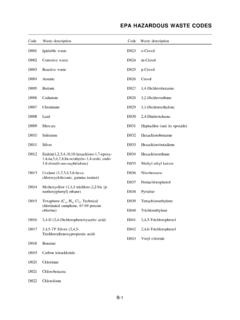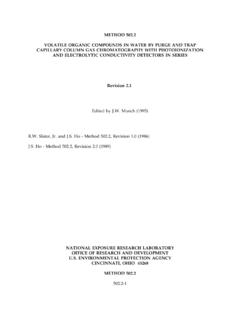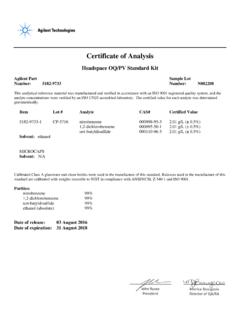Transcription of ANNUAL DRINKING WATER QUALITY REPORT
1 PRESORTED. FIRST CLASS MAIL. POSTAGE. PAID. HAVERTOWN, PA. PERMIT #45. 300 Forty Foot Road Lansdale, PA 19446. Ph: 215-855-3617. This REPORT is also available online at NPWA WATER meets or exceeds all State and Federal Safe DRINKING WATER Act standards. 2017. ANNUAL DRINKING WATER QUALITY REPORT . This REPORT is being mailed to you as a requirement PWSID#1460034. of the Federal Safe DRINKING WATER Act. A dedicated, professional workforce committed to providing the community with a safe, reliable, and economical WATER supply.. EDUCATIONAL INFORMATION. The sources of DRINKING WATER (both tap WATER and bottled WATER ) include rivers, Organic chemical contaminants, including synthetic and volatile organic chemicals, lakes, streams, ponds, reservoirs, springs and wells.
2 As WATER travels over the surface which are by-products of industrial processes and petroleum production and can also of land or through the ground, it dissolves naturally-occurring minerals and, in some come from gas stations, urban stormwater runoff and septic systems. cases, radioactive material, and can pick up substances resulting from the presence of Radioactive contaminants, which can be naturally-occurring or be the result of oil animals or from human activity. and gas production and mining activities. Contaminants that may be present in source WATER include: In order to ensure that tap WATER is safe to drink, EPA and DEP prescribe regulations Microbial contaminants, such as viruses and bacteria, which may come from sewage which limit the amount of certain contaminants in WATER provided by public WATER treatment plants, septic systems, agricultural livestock operations and wildlife.
3 Systems. FDA and DEP regulations establish limits for contaminants in bottled WATER Inorganic contaminants, such as salts and metals, which can be naturally-occurring which must provide the same protection for public health. or result from urban stormwater runoff, industrial or domestic wastewater DRINKING WATER , including bottled WATER , may reasonably be expected to contain at discharges, oil and gas production, mining or farming. least small amounts of some contaminants. The presence of contaminants does not Pesticides and herbicides, which may come from a variety of sources such as necessarily indicate that WATER poses a health risk.
4 More information about contaminants agriculture, urban stormwater runoff, and residential uses. and potential health effects can be obtained by calling the Environmental Protection Agency's Safe DRINKING WATER Hotline (800-426-4791). INFORMATION ABOUT LEAD. If present, elevated levels of lead can cause serious health you can minimize the potential for lead exposure by flushing problems, especially for pregnant women and young children. your tap for 30 seconds to 2 minutes before using WATER for Lead in DRINKING WATER is primarily from materials and components DRINKING or cooking. If you are concerned about lead in your associated with service lines and home plumbing.
5 North Penn WATER , you may wish to have your WATER tested. Information on WATER Authority is responsible for providing high QUALITY DRINKING lead in DRINKING WATER , testing methods, and steps you can take WATER , but cannot control the variety of materials used in plumbing to minimize exposure is available from the Safe DRINKING WATER components. When your WATER has been sitting for several hours, Hotline or at INFORMATION ABOUT ARSENIC. While your DRINKING WATER meets EPA's standard for arsenic, it does contain low levels EPA continues to research the health effects of low levels of arsenic which is a of arsenic.
6 EPA's standard balances the current understanding of arsenic's possible mineral known to cause cancer in humans at high concentrations and is linked to health effects against the costs of removing arsenic from DRINKING WATER . other health effects such as skin damage and circulatory problems. INFORMATION ABOUT NITRATE. Nitrate in DRINKING WATER at levels above 10 ppm is a health risk for infants of less rainfall or agricultural activity. If you are caring for an infant, you should ask advice than six months of age. High nitrate levels in DRINKING WATER can cause blue baby from your health care provider.
7 Syndrome. Nitrate levels may rise quickly for short periods of time because of CRYPTOSPORIDIUM AND GIARDIA. Cryptosporidium and Giardia are microbial pathogens found in surface WATER infection include nausea, diarrhea, and abdominal cramps. Most healthy individuals throughout the Monitoring of our source WATER (before treatment) at Forest can overcome the disease within a few weeks. However, immuno-compromised Park WATER (FPW) indicated the presence of Cryptosporidium in 6 out of 12 samples people, infants and small children, and the elderly are at greater risk of developing collected. Giardia was detected in 7 out of 12 samples collected.
8 FPW treatment life-threatening illness. NPWA encourages immuno-compromised individuals to processes are designed to remove or inactivate Cryptosporidium and Giardia cysts with consult their doctor regarding appropriate precautions to take to avoid infection. a high level of certainty. Current available test methods do not allow us to determine Cryptosporidium and Giardia must be ingested to cause disease, and it may be spread if the organisms are dead or if they are capable of causing disease. Symptoms of through means other than DRINKING WATER . Below is a list of parameters which NPWA monitored for in 2016 but DID NOT DETECT: Inorganic Chemicals (IOCs) Perfluorinated Compounds (PFCs).
9 Beryllium Cyanide Nickel Selenium Perfluorooctanesulfonic acid (PFOS). Cadmium Mercury Nitrite Thallium Perfluorononanoic acid (PFNA). Perfluorobutanesulfonic acid (PFBS). Coliform Bacteria Perfluoroheptanoic acid (PFHpA). E. Coli Total Coliform Bacteria Perfluorohexanesulfonic acid (PFHxS). Volatile Organic Chemicals (VOCs). 1,1,1-Trichloroethane 1,2-Dichloroethane Chlorobenzene Toluene 1,1,2-Trichloroethane 1,2-Dichloropropane cis-1,2-Dichloroethylene trans-1,2-Dichloroethylene 1,1-Dichloroethylene o-Dichlorobenzene Dichloromethane Trichloroethylene 1,2,4-Trichlorobenzene Benzene Ethylbenzene Vinyl Chloride p-Dichlorobenzene Carbon tetrachloride Styrene Xylenes, total Synthetic Organic Chemicals (SOCs).
10 1,2-Dibromo-3-chloropropane Dalapon Ethylene dibromide Oxamyl [Vydate]. 2,4-D Di(2-ethylhexyl) adipate Glyphosphate Pentachlorophenol 2,4,5-TP [Silvex] Di(2-ethylhexyl) phthalate Heptachlor Picloram Alachlor Dinoseb Heptachlor epoxide PCBs [Polychlorinated biphenyls]. Atrazine Dioxin [2,3,7,8-TCDD] Hexachlorobenzene Simazine Benzo[a]pyrene Diquat Hexachlorocyclopentadiene Toxaphene Carbofuran Endothall Lindane Chlordane Endrin Methoxychlor HOW NPWA IS PROTECTING THE WATER YOU DRINK. To enhance WATER QUALITY , NPWA performs an ANNUAL system reliability improvements. NPWA's participation in hydrant flushing program which takes place in the spring this voluntary program demonstrates our commitment to of each year.






